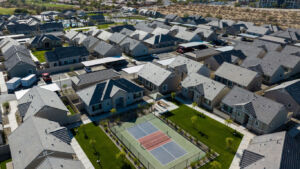“Change is slow” has perhaps become the world’s greatest misnomer, especially after the past year. The pandemic ushered in new, innovative technologies and novel way to move forward in the face of challenges.
COVID has been the impetus for nearly every industry to pivot and modify how they do business and in record-breaking time. From significant numbers of employees working from home and the shift to online services to an increased focus on health and wellness, every piece of the economy has been affected by these challenging times. As a result, real estate – particularly the rental and lease market – has seen its share of metamorphosis, as well.
READ ALSO: 5 Arizona housing market predictions for 2021
The leased housing market is experiencing tremendous demand from consumers, which has prompted builders and developers alike to propel the luxury build-to-rent community concept as one of the fastest-growing real estate sectors nationwide. The surge has not abated even during COVID. In fact, since the pandemic started, nearly 4,000 prospective residents took virtual tours of our models that allowed them to walk through a home on their own time, without the need for face-to-face interaction. In addition to a tight housing market, this unprecedented interest can be credited to the compelling attributes and features not typically available in traditional rental or leased communities, which have proved to be invaluable for renters seeking a detached single-family home lifestyle without a mortgage. National trends and consumer sentiment definitely point to the long runway of the built-to-rent housing demand.
Privacy and Space

As social distancing and stay-at-home lifestyles have become the norm, especially as the vast majority of people continue to work from home, renters by choice have been clamoring for more spacious and less dense living options than the typical tight living quarters that standard multifamily housing options tend to offer.
While renters of the past may have only required space to sleep and eat, housing expectations have now expanded to one-, two- and three-bedroom options as “must-haves” to allow residents freedom and flexibility in how they choose to live. Residents are also more particular about shared spaces and are willing to pay a premium for no shared walls, private backyards, and open floorplans that can provide an inviting work-from-home balance without feeling claustrophobic.
The inclusion of green spaces has also become a selling point in single-family rental or leased communities, as lockdowns have resulted in closures of public trails, parks, dog runs and more. Most people rediscovered exercise and escaped quarantine by utilizing the green spaces around their homes – and continue to demand them. Leased-home communities with walking trails, dog parks, and open community spaces have become significant points of differentiation for consumers who are comparison shopping.
Lifestyle of a Home, Freedom of a Lease
In addition to less dense environments, luxury single-family leased homes give residents the chance to enjoy features that are typically reserved for homeownership. Usually, co-existing with sometimes hundreds of families means sharing countless high-touch, high-interaction amenities, including elevators, HVAC systems, underground parking structures, laundry facilities, community mailrooms, and more.
Single-family luxury leased communities are flipping the switch and incorporating many of these once exclusive features into standard amenities. Among the most in-demand amenities are full-sized in-home laundry appliances, separate entries and private backyards, trash valets, and 24-hour maintenance. This new generation of renters by choice are also demanding open floorplans and high-end finishes – and developers are hearing the call.

Going the Extra Mile
While developers have always looked for the best real estate parcels upon which to build, COVID has ushered in an era of increased scrutiny when selecting future communities. As downtown cores have experienced an exodus into the suburbs, quality of life and access to public amenities have become increasingly important factors for renters. Suburban living has seen a resurgence, and developers are heading deeper into the outlying areas where lifestyle and community-based living are in high demand.
Builders are also incorporating cutting-edge community features that enhance living and contribute to wellness into units. For example, COVID has made people keenly aware of the importance of maintaining superior air quality to ward off mold, radon, carbon monoxide, and other toxic chemicals that manifest themselves in eye irritation, headaches, allergies, respiratory problems with prolonged exposure. At NexMetro, we have been working to ensure that our new Avilla Homes communities include environmentally friendly features including EPA airPLUS certifications, mold, and moisture control materials; efficient heating; ventilating and air-conditioning systems; combustion venting; no- or low-VOC paints and carpets; low-formaldehyde manufactured wood; sealed-home pest management systems; and radon-resistant construction. The result is a much cleaner and healthier living environment.
Eye to the Future
Gone are the days of build-it-and-they-will-come. There has never been more competition in the rental and lease market space for quality residents – and there are no signs that it is abating. Just as shoppers continue to demand the ease of grocery delivery or patients prefer virtual doctor visits, these COVID-born conveniences in luxury rental or leased real estate are here to stay as consumers become more discerning than ever and developers become more in tune and responsive to high-level market demands.
Josh Hartman is CEO of Phoenix-based NexMetro Communities, a leading national developer of luxury leased-home neighborhoods. The company has more than $1.5 billion invested in the Phoenix, Dallas, Denver, and Central Florida markets representing more than 40 neighborhoods completed, under construction and in development. NexMetro’s continued growth is a testament to its strategic nationwide expansion plans that speak directly to lifestyle-conscious consumers from all walks of life who would rather lease than own a home.




